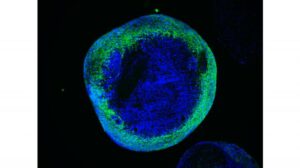First human model for Leigh syndrome

Human brain organoids with mature neurons in green. ©Dr. Agnieszka Rybak-Wolf
Leigh syndrome is the most severe mitochondrial disease in children. This orphan disease causes severe muscle weakness, movement defects, and intellectual disabilities. It usually leads to death within the first years of life and there is currently no curative treatment. One of the genes frequently mutated in patients is SURF1, which encodes for a protein involved in the process of energy generation in the cells. Animal models did not recapitulate the defects seen in the patients carrying mutations in SURF1. Therefore, the scientists did not have the tool to start understanding the disease mechanisms and to identify possible targets for treatment.
A new model based on brain organoids
The group of Prof. Alessandro Prigione at the Department of General Pediatrics at the University Hospital Duesseldorf, Germany, in collaboration with the groups of Prof. Markus Schuelke at the Department of Neuropediatrics, Charite Universitaetsmedizin Berlin, and Prof. Nikolaus Rajewsky at the Berlin Institute for Medical Systems Biology (BIMSB), Max Delbrueck Center for Molecular Medicine (MDC), have now developed the first human model of Leigh syndrome caused by SURF1 mutations. Their report about this first human model is now published in Nature Communications (1). To achieve this, the authors employed the technology of cellular reprogramming, which enables to convert cells from the skin into stem cells that are capable of generating neurons. They then used the molecular scissors CRISPR/Cas9 to precisely remove the mutation from the patient cells and to introduce the mutations into the control cells. Thus the authors were able to investigate the specific effect of SURF1 mutations in a controlled genetic background. They next generated neurons and brain organoids. Pr Alessandro Prigione commented: ” Two-dimensional (2D) cultures cannot allow to assess the architectural complexity and regional organization of the brain. Three-dimensional (3D) brain organoids from patient-specific iPSCs enable to gain this additional information, and can help understanding how diseases might impair the development and functionality of the nervous system. So for this reason, organoids are a better model to study intellectual disability, as they can show how the development of the architectural complexity of the brain may be affected in patients“. Using these models, the authors discovered that the neuronal defects seen in the patients may be caused by an energy deficit occurring at the level of neural precursors, which are the cells that generate neurons. These energy defects lead to insufficient neuronal branching, which causes improper brain function during development. Finally, the authors demonstrate that the neuronal branching defects can be corrected by improving the energy output of progenitor cells using SURF1 gene replacement therapy or by using the drug Bezafibrate, which is currently safe for clinical use in children.
Two therapeutic strategies to revert the disease
In brain organoids from Leigh syndrome patients, neurons do not mature properly, due to an impaired activation of mitochondrial metabolism in neural precursors. The authors demonstrate that helping this activation can revert the neurodevelopmental defects. They achieved this using two strategies that may be applicable in the clinics: 1) gene correction with CRISPR/Cas9 or viral-based delivery of a healthy copy of the gene affected in patients, 2) increasing the expression of the metabolic regulator PGC1-alpha using the FDA-approved drug bezafibrate. These findings are important since they provide for the first time a model for studying the neuronal pathology of Leigh syndrome caused by SURF1 mutations. Moreover, these results could open the door to new practical strategies for treating children affected.
(1) Inak, G., Rybak-Wolf, A., Lisowski, P. et al. Defective metabolic programming impairs early neuronal morphogenesis in neural cultures and an organoid model of Leigh syndrome. Nat Commun12, 1929 (2021). https://doi.org/10.1038/s41467-021-22117-z




COMMENTS ARE OFF THIS POST